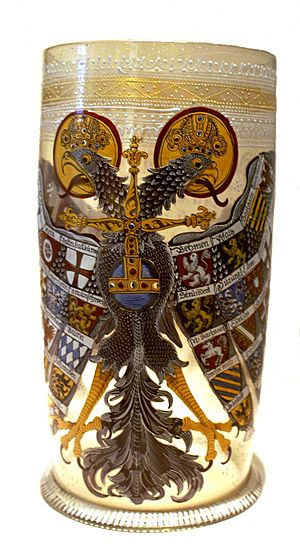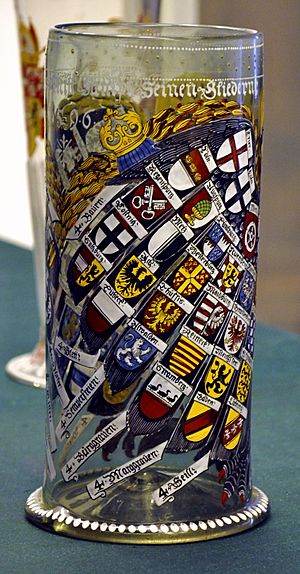Imperial Eagle beaker facts for kids
An Imperial Eagle beaker (also called an eagle glass) was a special drinking cup popular in the Holy Roman Empire from the 1500s to the late 1700s. These cups were made of enamelled glass and decorated with a double-headed eagle. This eagle was known as the Reichsadler, which means "Imperial Eagle," and it was the symbol of the Empire. The word "humpen" means a large, cylindrical drinking glass.
These beakers were very popular because they were colorful and decorative. They also showed that the owner was loyal to the Holy Roman Empire. People also liked them because they were quite large! Another popular type of beaker was decorated with pictures of the emperor and the important electors (princes who chose the emperor).
Today, you can see many beautiful Imperial Eagle beakers in museums around the world. Well-preserved ones can even sell for thousands of Euros at auctions!
Contents
What Did They Look Like?
Most Imperial Eagle beakers were quite large, holding about three to four liters of liquid. They were usually 20 to 32 centimeters (about 8 to 13 inches) tall and 10 to 15 centimeters (about 4 to 6 inches) wide. They were made from white or colored glass. Sometimes, they even had a lid and a base made of brass or tin.
How Were They Decorated?
The colorful pictures on the beakers were painted using a special method called glass enamel. This technique came to Germany from Venice. To do this, artists mixed paints with tiny pieces of crushed glass. After painting the design, the glass was heated again. This melted the paint onto the surface, making the colors bright and long-lasting.
The Imperial Eagle Design
The main decoration was the double-headed eagle. At first, the eagle often had a holy cross or a picture of Jesus on its chest. This showed that the Empire was founded on Christian beliefs and that the eagle protected the church. Later, in the 1600s, the cross or Jesus was usually replaced with a picture of the Empire's orb, which was another symbol of the Empire.
The eagle's wings were covered with 56 different coats of arms. These represented the important parts of the Empire, like the electors, other powerful families, and imperial cities. The coats of arms of the electors and even the Pope were placed near the eagle's head. Below them, there were twelve rows, each with four coats of arms. The double-headed eagle itself was crowned and had a halo, showing that the Empire was considered sacred.
Messages on the Beakers
Often, you could find special messages on the back of the Imperial Eagle beakers. These might explain the pictures, give the date it was made, or even name the glassmaker.
For example, on a beaker from 1669, now in the "Grimma" museum, you can read: The Holy Roman Empire; with all members in the year 1669 Hanß George Sommer
The large size of these beakers suggests they were used for sharing drinks at important events. They were also popular at meetings of guilds (groups of craftsmen). Toasts and blessings found on some beakers, especially from after the Thirty Years' War, show they were used in welcoming ceremonies.
History and Meaning
In the 1500s and 1600s, pictures of the emperor, electors, and the imperial eagle were very popular. Artists often made wood or copper engravings of these images. These artworks then inspired the decorations on everyday items, like Imperial Eagle beakers, stoneware mugs, pewter plates, and even stove tiles.
Oldest Examples and Production
The oldest known Imperial Eagle beaker dates back to 1571 and is now in the British Museum in London. Another very old one, from 1572, is displayed at the 'Württembergischen Landesmuseum' in Stuttgart. These beakers continued to be made almost the same way until the mid-1700s. They were mainly produced in regions like Bohemia, Saxony, Thuringia, Hesse, and the Fichtelgebirge. These beakers were so important that in 1669, the glassmakers' guild in Bohemia even required new glassmakers to create an Imperial Eagle beaker as a "masterpiece" in just a day and a half!
Showing Loyalty to the Empire
The Imperial Eagle beakers helped show the idea of a strong and united Holy Roman Empire. They allowed ordinary people to feel a connection to the Empire. The eagle was often shown in a special way that helped explain how the Empire was organized. Even back then, people needed help understanding the Empire's structure. This special way of showing the eagle helped explain it.
Drinking was a very important social custom in those times, with lots of toasting. So, having an Imperial Eagle beaker was a way for the owner to show their loyalty and connection to the Empire. This connection was especially strong for everyday people and the middle classes. That's why Imperial Eagle beakers were mostly owned by lower-ranking nobles, wealthy citizens, and members of city guilds. Most of the known owners were craftsmen and guilds, with only a few found among very high-ranking nobles.
Cultural References
The term "Roman Empire" was often linked to these beakers. In a book from 1616, it was suggested that to cheer up, one should "invite merry men / and good friends round / to wipe the dust off the Roman Empire and other drinking lords / and so encourage merry revelling and drinking parties."
Some historians believe that the famous writer Johann Wolfgang von Goethe might have been thinking of an Imperial Eagle beaker when he wrote a scene where people sing: The dear Holy Roman Empire, how does it stay together?
Sadly, by the late 1800s, many fake Imperial Eagle beakers were being made.



